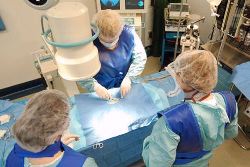
*The following article is the Executive Summary from the booklet “Assessing Biocompatibility: A Guide for Medical Device Manufacturers”
Purpose of Biocompatibility Testing
Biocompatibility is, by definition, a measurement of how compatible a device is with a biological system. The purpose of performing biocompatibility testing is to determine the fitness of a device for human use, and to see whether use of the device can have any potentially harmful physiological effects. As stated by the International Organization of Standards:
“The primary aim of this part of ISO 10993 is the protection of humans from potential biological risks arising from the use of medical devices.” (ISO 10993-1:2009)
The overall process of determining the biocompatibility of any medical device involves several stages. One should begin by collecting data on the materials comprising the device, then perform in vitro screening (often only on components of the device), and finally conduct confirmatory in vivo testing on the finished device. It is essential to make sure that the finished device is challenged to ensure that human use of the device does not result in any harmful effects.
Biocompatibility Test Planning
The primary goal of a biocompatibility screening program is the protection of humans. However, since animal testing is necessary for many biocompatibility tests, a secondary goal is to eliminate unnecessary testing and minimize the number and exposure of test animals. With this in mind, it is important to conduct research beforehand to document all relevant data on the component materials of the device and on similar devices with an established clinical history. Existing data may be sufficient to demonstrate biological safety of parts or of the entire device, thus precluding the need to conduct certain tests.
The required tests will also depend on the use of the device and the manner and duration in which it will interact with the body. In test planning it is important to note whether the device is a surface device, an external communicating device, or an implant device, and what tissues the device will contact. (Implant devices interacting with the blood, for instance, will require more thorough testing than a surface device with an expected contact time of only a few days.)
When planning, it is also important to note that Good Laboratory Practice (GLP) compliance is required for certain biocompatibility regulatory submissions. Because of this, it is generally a good idea to conduct biocompatibility testing according to GLP to allow for the maximum regulatory flexibility and compliance.
Conducting Tests
Typically, material characterization and analysis of the device’s components are conducted prior to any biological testing. This involves extracting leachable materials from the device or components at an elevated temperature, and analyzing the leachable extracts for potentially harmful chemicals or cytotoxicity.
 Once in vitro testing has been completed, in vivo biological testing can be done based upon the device’s intended use. This testing can range from skin irritation testing to hemocompatibility and implantation testing. Turnaround time for tests can range from three weeks to greater than several months, depending on the specific test data needed. Subchronic or chronic implantation testing can last even longer.
Once in vitro testing has been completed, in vivo biological testing can be done based upon the device’s intended use. This testing can range from skin irritation testing to hemocompatibility and implantation testing. Turnaround time for tests can range from three weeks to greater than several months, depending on the specific test data needed. Subchronic or chronic implantation testing can last even longer.
Evaluating the Data
After tests are completed and all data has been collected, it is recommended that an expert assessor interpret the data and test results. This will provide insight on whether additional tests need to be conducted, or whether the existing data provide enough information for an overall biological safety assessment of the device.
Additional Information
If you’d like to learn more about how to plan for biocompatibility testing, and for detailed information on ISO and FDA regulations for medical devices, download the 26-page booklet on Assessing Biocompatibility.
Pacific BioLabs performs many different types of medical devices services, including medical device biocompatibility.
